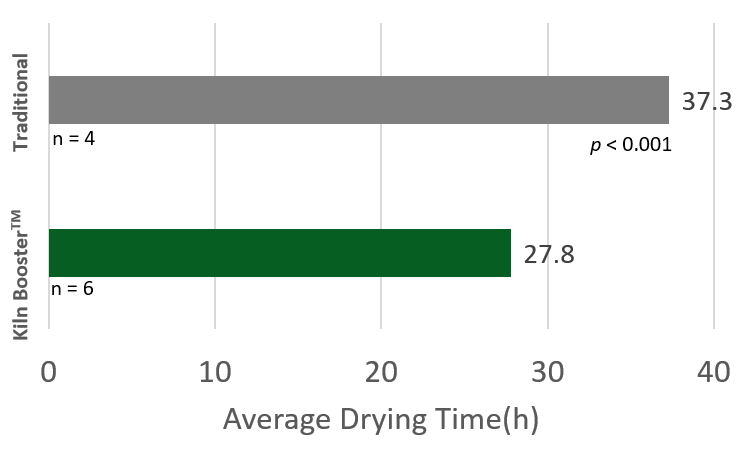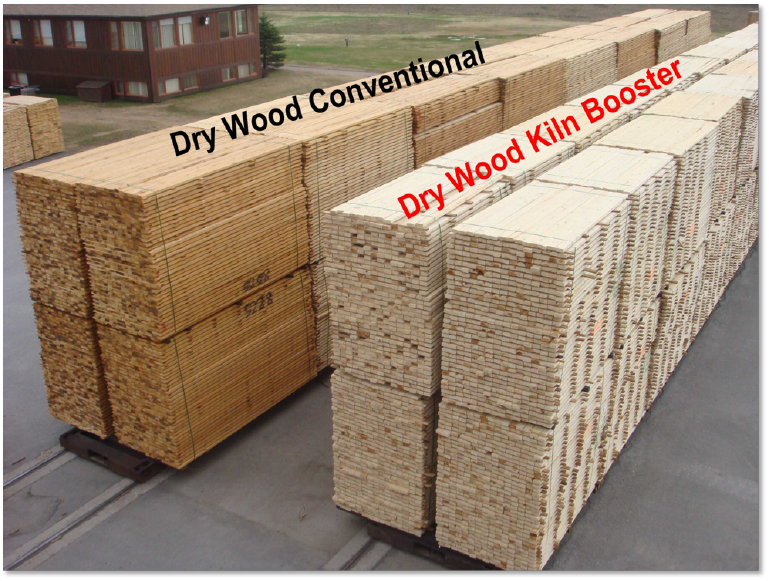
The Kiln Booster™ technology is based on resonance and was entirely researched and developed by a team of engineers with more than 30 years of experience in lumber drying at SECOVAC. Read on to learn more.
The system is supported by multiple field tests that demonstrate that the Kiln Booster™ system accelerates the drying of the lumber, improves quality of dried lumber, and is cost-effective.

The graph on the left shows 25.5% shorter drying schedules using the low-temperature Kiln Booster system when compared to traditional higher-temperature drying for black spruce (2”x4”).
A total of 24 batches of pre-sorted SPF lumber were dried in a direct fire kiln during 6 consecutive weeks using the Kiln Booster™ system and its corresponding drying schedules. On average, the mill observed an 18% decrease in drying times across all pre-sort categories but saw the biggest benefits for their wetter sorts with a decrease in drying times of more than 30% for their super wet sort.
The average time gains were calculated using the previous years average drying times. The dry kiln was operated using a control system that allows drying at and controlling the schedules through constant TDAL.

The Kiln Booster™ system should be utilized with the Kiln Booster™ drying schedules as the technology is temperature sensitive. That is, the system does not perform at wet bulb temperatures higher than 155°F. Below is an example of a standard Kiln Booster™ drying schedule for SPF 2x4. The schedules provided should be considered as standard starting points from which a mill can then develop their own optimal site-specific drying procedures (within provided temperature parameters).
Vent Enable Time: 2h once warm-up (step1) is complete
MC Lockout: 2h after step 3 is complete

*Auto Adv refers to drying at constant TDAL. Same TDAL multiplier should be used for steps 3 and 4.
Contact us to receive the complete list of Kiln Booster™ drying schedules or for assistance getting the schedule set-up on your kiln.
The lower drying temperature decreases significantly the drying defects and prevents darkening of the lumber. In practice, most mills see an increase in their grade outturn.

Even when the load to dry consists of different species and initial moisture contents (MC), the use of the Kiln Booster system reduces moisture variations of the wood resulting in homogeneous moisture and less kiln wet.
The histogram on the right shows a typical distribution of MC results of a spruce load dried with the Kiln Booster with a standard deviation of 2.2 (operating temperatures: 150°F/120°F).

Hassle-free installation on existing kilns
Seamless integration with controller
No additional space required
The Kiln Booster™ system consists of a small wave generator panel (12’’H x 10’’W x 6’’D) and a connected pair of antennas. The antennas are installed inside the kiln, along the wall, and transmit a low-intensity electromagnetic wave throughout the kiln. The total power consumption of the Kiln Booster™ wave generator is 0.004 Amps (4 mA) at 120 VAC. This power is used by the 2 leds, Omron feedback relay, power supply and the signal generator.


The Kiln Booster™ system does not control the drying cycle. The system turns on automatically when the drying begins and shuts off when it is complete. During the drying cycle, a continuous electrical wave is sent throughout the kiln to help maximize the heat transfer within the dry kiln, enabling efficient low temperature drying, and radically improving dry lumber quality.
Request more information